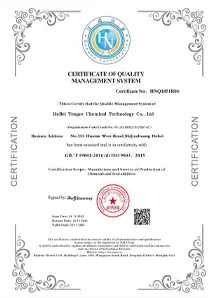
aluminum hydroxide for cats
Aluminum Hydroxide for Cats A Comprehensive Overview
Aluminum hydroxide, a compound often utilized in various medical and health applications, is gaining recognition in veterinary medicine, particularly in the treatment of certain conditions in cats. In this article, we will explore what aluminum hydroxide is, its uses in feline health, and any potential concerns associated with its use.
What is Aluminum Hydroxide?
Aluminum hydroxide is a compound made up of aluminum, oxygen, and hydrogen, and is most commonly known for its use as an antacid in human medicine. It works by neutralizing stomach acid and is also employed as a phosphate binder in individuals with chronic kidney disease. In veterinary medicine, aluminum hydroxide is used primarily to help manage phosphate levels in cats that suffer from kidney disease.
Kidney Disease in Cats
Chronic kidney disease (CKD) is a common ailment in older cats. As their kidneys become less efficient at filtering waste and excess minerals from the blood, phosphorus levels can rise, leading to a condition known as hyperphosphatemia. Elevated phosphorus levels can lead to additional complications, including bone disease and cardiovascular issues. Aluminum hydroxide serves an essential role by binding to dietary phosphate in the intestines, preventing its absorption into the bloodstream and helping to keep phosphate levels under control.
Administration and Dosage
aluminum hydroxide for cats

Veterinary professionals typically recommend aluminum hydroxide in either powder or gel form. It can be mixed with food or given directly. The dosage of aluminum hydroxide should always be determined by a veterinarian based on the individual cat’s needs, as factors such as age, weight, and overall health condition can influence the appropriate amount. Owners must follow the veterinarian’s guidelines closely to ensure their cat receives the correct dosage without risking any complications.
Benefits of Aluminum Hydroxide
The primary benefit of using aluminum hydroxide in cats with CKD is its ability to manage hyperphosphatemia effectively. Keeping phosphorus levels in check not only helps alleviate symptoms associated with kidney disease but also enhances the overall quality of life for affected cats. By minimizing the risk of phosphate-induced complications, aluminum hydroxide can assist in prolonging healthy living for these cats.
Potential Concerns and Side Effects
While aluminum hydroxide is generally considered safe for use in cats, there can be side effects. Some cats may experience gastrointestinal upset, including diarrhea or constipation. Long-term use raises concerns about aluminum accumulation in the body, particularly in those with pre-existing conditions. Regular veterinary check-ups and monitoring are essential when administering this compound to ensure that it remains safe and effective for your feline friend.
Conclusion
Aluminum hydroxide represents a valuable tool in managing chronic kidney disease in cats, particularly for controlling phosphate levels. Its benefits in improving the health and quality of life for affected felines can be significant, but it is crucial for pet owners to work closely with their veterinarians to manage dosage and monitor for side effects. By staying informed and proactive, cat owners can help their furry companions navigate the challenges posed by kidney disease while ensuring their continued well-being.
-
Understanding Synthetic Rubber OptionsNewsApr.27,2025
-
Trichloroisocyanuric Acid: Essential for Clean and Safe WaterNewsApr.27,2025
-
Sodium Dichloroisocyanurate: Key to Safe Water TreatmentNewsApr.27,2025
-
Sodium Acid Pyrophosphate: Essential in Modern Food ProcessingNewsApr.27,2025
-
Essential Water Treatment ChemicalsNewsApr.27,2025
-
Denatured Alcohol and Its Industrial UsesNewsApr.27,2025
-
The Versatile Uses of Sodium BicarbonateNewsApr.24,2025
Hebei Tenger Chemical Technology Co., Ltd. focuses on the chemical industry and is committed to the export service of chemical raw materials.
-

view more DiethanolisopropanolamineIn the ever-growing field of chemical solutions, diethanolisopropanolamine (DEIPA) stands out as a versatile and important compound. Due to its unique chemical structure and properties, DEIPA is of interest to various industries including construction, personal care, and agriculture. -

view more TriisopropanolamineTriisopropanolamine (TIPA) alkanol amine substance, is a kind of alcohol amine compound with amino and alcohol hydroxyl, and because of its molecules contains both amino and hydroxyl. -

view more Tetramethyl Thiuram DisulfideTetramethyl thiuram disulfide, also known as TMTD, is a white to light-yellow powder with a distinct sulfur-like odor. It is soluble in organic solvents such as benzene, acetone, and ethyl acetate, making it highly versatile for use in different formulations. TMTD is known for its excellent vulcanization acceleration properties, which makes it a key ingredient in the production of rubber products. Additionally, it acts as an effective fungicide and bactericide, making it valuable in agricultural applications. Its high purity and stability ensure consistent performance, making it a preferred choice for manufacturers across various industries.











